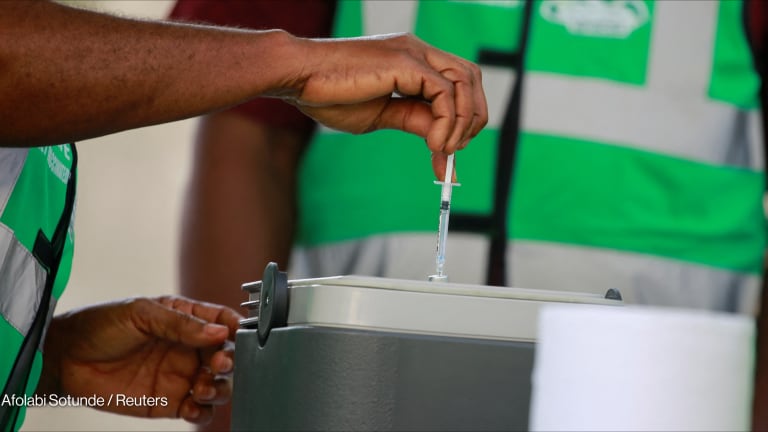
The Access to COVID-19 Tools Accelerator, or ACT-A, the global partnership set up to accelerate the development and delivery of COVID-19 tests, treatments, and vaccines, launched on Thursday its new plan and budget for the period of October 2021 to September 2022.
Sign up for Devex CheckUp
The must-read weekly newsletter for exclusive global health news and insider insights.
Under the new plan, ACT-A is “shifting” its focus from “being the global solution for equitable allocation of COVID-19 tools” to addressing access inequities to COVID-19 tools in underserved areas, including in humanitarian settings.
Within the next 12 months, agencies part of ACT-A aim to support low- and middle-income countries in vaccinating 70% of their population, increasing their testing rates to at least 1 per 1,000 people per day, and treating up to 120 million COVID-19 cases through the deployment of existing treatments and in enabling access to new therapies.
Agencies said they will need a total of $23.4 billion to deliver on these targets, and changes in the current system — such as more transparency from manufacturers and countries — to ensure access to COVID-19 tools.
There remain huge disparities in COVID-19 vaccine coverage across the globe. Advocates are also concerned that global, equitable access to potential new therapies like molnupiravir may be hampered by restrictions on licensing agreements.
“Without the transparency from those entities, it's really difficult for the world to have clarity on how we're going to … end this pandemic.”
— Dr. Kate O’Brien, director, immunization, vaccines, and biologicals department at WHONeed for more transparency
During a press briefing ahead of the plan’s launch, Dr. Kate O’Brien, director of the World Health Organization’s immunization, vaccines, and biologicals department, said over 6.8 billion doses of COVID-19 vaccines have already been administered globally by mid-October, but the world is nowhere near ending the pandemic, due in part to vaccine inequity.
This will need to change for countries to vaccinate 70% of their population by mid-2022. O’Brien said an additional 5 billion COVID-19 vaccine doses will be needed for that to happen, and COVAX will be contributing to that supply.
But there needs to be more transparency from manufacturers and countries that have contracted high volumes of vaccine or have committed to donate doses to COVAX, she said. Manufacturers have experienced delays in delivering doses for a number of reasons, including mishaps at manufacturing sites. But what’s unclear is whether those bottlenecks are being felt by all parties whom companies have agreed to supply, O’Brien said.
“I think what we're trying to understand is if they’re preferentially putting COVAX at the head of the line, or at the bottom of the line, or somewhere in the middle, [and] are those bottlenecks being equally felt across all of the contracts,” she said.
O’Brien also said it’s unclear what’s included in manufacturers’ bilateral contracts with countries. In addition, countries’ pledged doses to COVAX of up to 800 million doses are still being confirmed.
“Without the transparency from those entities, it's really difficult for the world to have clarity on how we're going to reach the ambitions that all countries need to have in order to end this pandemic,” she said.
Clearer deliverables for health systems?
The new strategy also lays out a refreshed plan for the health systems pillar, whose function has been quite obscure. Civil society representatives hoped that within the next 12 months, the pillar would not just focus on providing personal protective equipment, but also in training and recruiting additional health workers.
Merck expands manufacturing for molnupiravir. But questions remain.
While there is cautious optimism about molnupiravir, experts warn of concerns around equitable access in middle-income countries, and the drug’s safety and efficacy across populations.
Under the new strategy and budget plan, the health systems pillar, now called “health systems and response connector,” will require $5.9 billion to deliver personal protective equipment to 2.7 million workers, but also to ensure the delivery of new COVID-19 tests, treatments, and other tools to countries.
Agencies under the pillar will also be working closely with WHO’s health emergencies team to ensure they are more responsive to country needs and are aligned with countries’ national plans. UNICEF is also joining the pillar as a co-convenor together with WHO, World Bank and the Global Fund to Fight AIDS, Tuberculosis and Malaria.
The pillar can help countries “be more systematic and more dynamic” in their needs assessment and in accessing different funding sources. It can also help ensure that the tests, treatments and vaccines that the other pillars aim to deliver are actually taken up in countries, as well as in building resilience in countries’ health systems, which includes ensuring “there are enough health workers able to do their jobs,” said Peter Sands, Global Fund’s executive director, during another press briefing.
But Sands said it’s difficult to define precisely the targets for the health systems and response connector pillar.
“The health systems and response connector [pillar] often acts as a bit of a gap filler between what countries are doing themselves ... as part of the broader response and the product pillars, and so its role varies depending on the country and depending on the particular arena,” he said.









